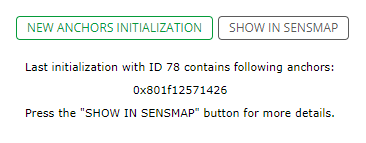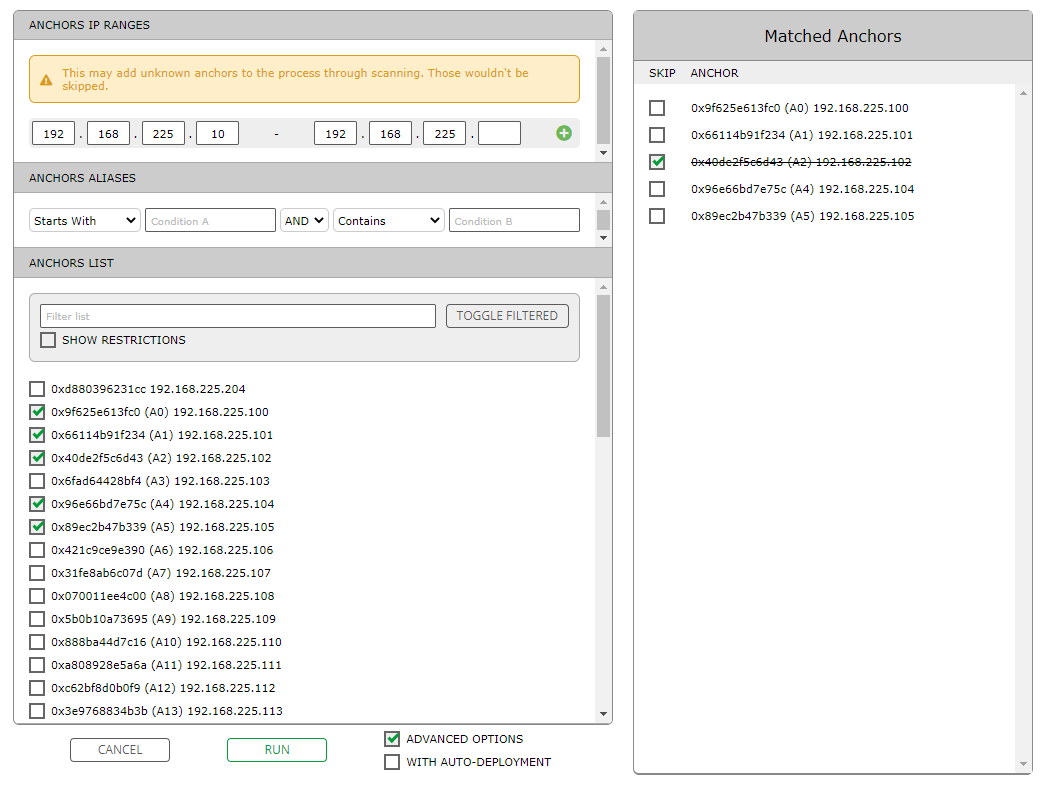Sectional Initialization
Expanding a large RTLS installation used to be a time consuming process, due to the fact that the full initialization was required for all Anchors in the system. This is no longer an issue with new sectional initialization. With the use of several filters and selectors, you are now able to decide what Anchors should be included in the new initialization. Please refer to guides below for information on how to select Anchors for sectional initialization.
This section includes:
Sectional Initialization GUI
If there has been any initialization run before, it is now displayed in the initialization tab of RTLS Manager with a list of Anchors that have been used in the initialization.
The "SHOW IN SENSMAP" button will redirect you to Sensmap with the details of the last initialization.
To proceed to sectional initialization press the "NEW ANCHORS INITIALIZATION" button.
Without Advanced Options
When the "ADVANCED OPTIONS" checkbox is not checked there is only a simple IP range selection.
You can add multiple IP ranges. Don't worry if these ranges overlap, the RTLS Manager will handle it.
The IP ranges that are greyed out are not valid and will NOT be used during the initialization.
There must be at least one valid IP range before the initialization process can start.
Every anchor that will be found in the selected IP ranges will be used in initialization.
The "WITH AUTO-DEPLOYMENT" checkbox works as it used to. It simply tells the initialization that it should also measure the distance between Anchors and create an auto-deployment from the measurements.
You can always go back to the previous window by pressing the "CANCEL" button.
With Advanced Options
If the "ADVANCED OPTIONS" is checked the more detailed options are revealed.
ANCHORS IP RANGES
The IP ranges act the same as they did in the previous section. The only exception is that you can run initialization without any IP range when using advanced options.
ANCHORS ALIASES
You can select the anchors by aliases. There are several options you can choose from when building the alias filter.
- Contains: The alias has to contain the text in the exact form
- Doesn't Contain: The alias cannot contain the text in the exact form
- Starts With: The alias has to start the same as the text
- Ends With: The alias has to end the same as the text
- Equals: The alias has to be the same as the text
- Is Empty: The anchor cannot have any alias
- Is Not Empty: The anchor must have an alias
You can define two rules for the alias and select if you want both of them to apply (AND) or if you want at least one of them to apply (OR).
ANCHORS LIST
If you need to specify what anchors should be initialized manually you can through the Anchors' list.
There are several features to help you with this task.
There is a filter you can use to filter anchors by MAC address, alias, or even IP.
The "TOGGLE FILTERED" button will select or unselect all of the anchors currently in the list.
The "SHOW RESTRICTIONS" checkbox will show anchors set in Anchor restrictions under each anchor that has them.
MATCHED ANCHORS
In the list on the right, there are all the known Anchors that will be used during the initialization.
Please note, that Anchors selected using IP ranges may not appear in the list (because they are unknown to the system before scanning), but still be used during the initialization.
If there are some anchors in the final list that you still don't want to use in the initialization you can check the "SKIP" checkbox next to any of them.
Selecting Anchors for Initialization
There are several factors user has to keep in mind when running Anchor's initialization. This page is here to help with selecting the correct anchors for sectional initialization.
Why do we need to initialize the Anchors?
The main goal of the initialization is to find the most suitable master anchors. This is done by observing the UWB signal between every pair of anchors.
If the anchors are using TCP synchronization the initialization measurements are also used for selection of bridges. This is the main reason we should focus on what anchors should be selected during the sectional initialization.
Please keep in mind, the master suggestions are being presented only when all of the anchors are selected for initialization. Barometers are calibrated also only for the full initialization.
When performing a sectional initialization the user has to manually select new masters by analyzing the environment and the measured signal parameters.
How to select the right Anchors for initialization?
The most simple rule for sectional initialization would be: When adding new anchors always select these anchors and already initialized anchors that could be in reach of them.
When adding the new section that is completely separated from the already existing installation. You can run the initialization only for the new anchors.
By doing this the system will always know how well the new anchors can reach the old ones.
Same goes if anything changes. If you change the position or the environment around one anchor, you should always add all the surrounding anchors in reach to the initialization process as well.
If you only need to select some anchors to calculate the auto-deployment, you can select only the anchors you want in this auto-deployment.


